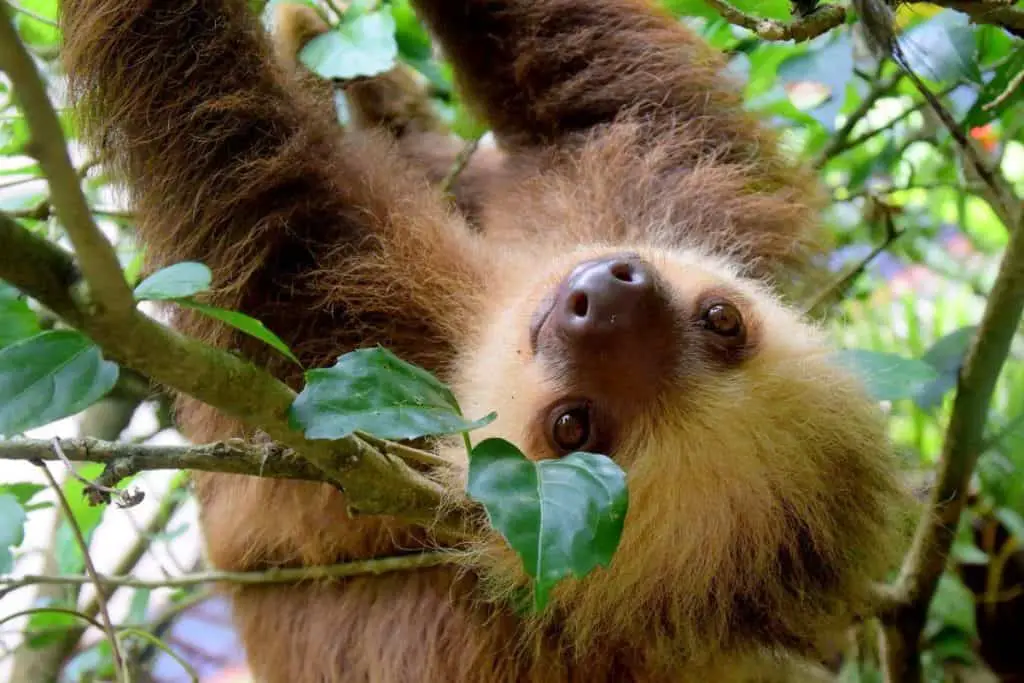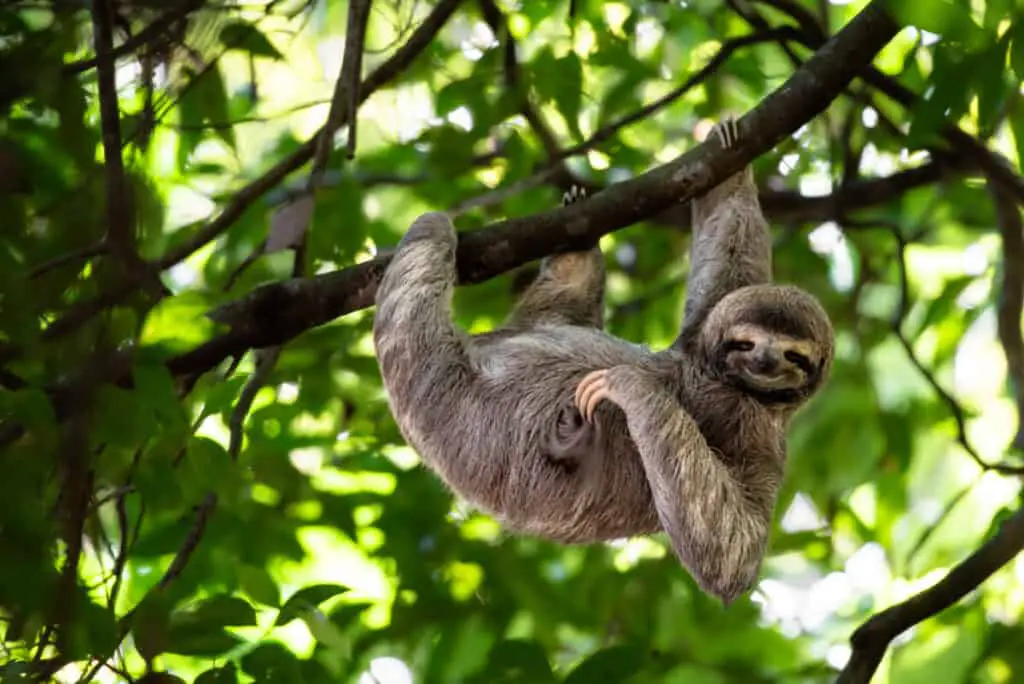Sloths are mammals found in Central and South America known for its slow movement and arboreal lifestyle.
There are six species of sloths, divided into two families: the two-toed (Choloepus) and three-toed (Bradypodidae).
Sloths have been studied extensively due to their unique anatomy, physiology, behavior, and ecology.
Sloths are characterized by their low metabolic rate, which allows them to conserve energy while living on a diet consisting mainly of leaves.
They spend most of their time hanging upside down from tree branches with long claws that allow them to grip tightly.
The sloth’s body is adapted to this lifestyle with specialized features such as an elongated vertebral column and reduced muscle mass.
Despite their lethargic appearance, sloths play important roles in tropical ecosystems as seed dispersers and food sources for predators.
This article will delve deeper into the fascinating world of sloths, exploring their evolutionary history, ecological roles, and conservation status.

| Species | Scientific Name | Distribution |
|---|---|---|
| Brown-throated Sloth | Bradypus variegatus | Central and South America |
| Pale-throated Sloth | Bradypus tridactylus | Central and South America |
| Linnaeus’s Two-toed Sloth | Choloepus didactylus | Central and South America |
| Hoffman’s Two-toed Sloth | Choloepus hoffmanni | Central and South America |
| Maned Sloth | Bradypus torquatus | Brazil, French Guiana |
| Pygmy Three-toed Sloth | Bradypus pygmaeus | Isla Escudo de Veraguas, Panama |
Anatomy And Physiology Of The Sloth
The sloth is a fascinating creature that boasts unique physiological characteristics. To fully understand this animal’s anatomy and physiology, one must first appreciate the fact that it has evolved to be incredibly slow-moving. In fact, its metabolism is so sluggish that it can take up to a month for food to move through their gut.
One of the key adaptations that allows the sloth to survive on such a low-energy diet is its unique digestive system. Unlike other mammals, which have multiple stomachs for breaking down tough plant material, the sloth has an elongated colon with several specialized compartments.
These compartments contain symbiotic bacteria that help break down cellulose and extract nutrients from plants more efficiently. This enables sloths to subsist solely on leaves and avoid having to expend energy searching for other sources of food.
Overall, the sloth’s remarkable combination of slow metabolism and specialized digestive system make it a truly remarkable and highly adapted species.
Family Bradypodidae: Navigating the Slothful World
The Two-Toed And Three-Toed Sloth Families
The anatomy and physiology of the sloth is an important foundation for understanding the differences between the two-toed and three-toed sloth families.
While these species share many similarities in their slow-moving nature and unique adaptations to arboreal life, there are key behavioral differences that distinguish them from one another.
For instance, while both types of sloths have a diet consisting almost entirely of leaves, they differ in their preferences for certain plants.
Two-toed sloths tend to favor younger leaves because they contain more protein than mature ones, whereas three-toed sloths rely heavily on just a few select tree species that produce nutrient-rich leaves year-round.
Additionally, two-toed sloths are more active during daylight hours and can often be seen moving about within the canopy, while three-toed sloths typically only move when necessary to find food or change trees.
These subtle yet significant behavioral variations highlight the divergent evolutionary paths taken by each family over time.
- Sloth Family Differences:
- Diet Preferences
- Two-Toed: Younger Leaves (more protein)
- Three-Toed: Nutrient-Rich Year-Round Leaves
- Activity Levels
- Two-Toed: More Active During Daylight Hours
- Three-Toed: Only Move When Necessary – Physical Characteristics
The Sloth’s Arboreal Lifestyle
The arboreal lifestyle of the sloth is one that has been shaped by various ecological and physiological factors. Sloths spend most of their lives hanging upside down from branches, a behavior that helps them conserve energy. This posture also offers protection against predators as it makes them harder to see in dense foliage. However, this lifestyle presents unique challenges such as limited mobility on the ground which can make sloths vulnerable when they come down to defecate once a week.
Sloths have a slow metabolism due to their low-energy diet of leaves, flowers, and fruit. This metabolic strategy allows for a reduction in oxygen consumption and carbon dioxide production while conserving energy. Additionally, sloths have reduced muscle mass compared to other mammals because muscle tissue requires more energy to maintain than fat tissue. These adaptations help sloths survive in environments where food availability is low and unpredictable. Despite these constraints, sloths are able to thrive in their arboreal habitats thanks to their specialized morphology and behavior that allow them to navigate through complex vegetation with ease.
| Advantages | Disadvantages |
|---|---|
| Energy conservation | Limited mobility on ground |
| Predator avoidance | Low-energy diet |
| Protection from harsh weather conditions | Reduced muscle mass |
Ecological Roles Of Sloths In Tropical Ecosystems
Sloths are known for their slow-moving nature and low energy expenditure which makes them appear as insignificant animals. However, they play important ecological roles in tropical ecosystems that contribute to the health of these systems.
Sloths serve as a keystone species, meaning they have a significant impact on the structure and function of their habitats. They help maintain tree diversity by eating leaves from different plant species, thus promoting growth of other plants.
Additionally, sloths provide important resources for other organisms through symbiotic relationships with moths and algae. The fur of sloths is home to many moth species that lay eggs in it. These moths feed on algae growing on the fur which provides an essential source of nutrients for them. In turn, this relationship benefits the sloth by providing camouflage against potential predators.
Furthermore, when sloths defecate at the base of trees after feeding high up above ground level, their excrement serves as fertilizer for those trees and other surrounding vegetation creating positive effects throughout their ecosystem.
Threats To Sloth Populations And Conservation Efforts
Sloths face a number of threats, including poaching and habitat loss.
Poaching is primarily driven by the demand for sloth fur or meat in traditional medicine practices. While many countries have laws protecting sloths from hunting and trade, enforcement can be difficult, particularly in areas with limited resources.
Habitat loss is also a significant threat to sloth populations as deforestation continues at an alarming rate throughout their range. This not only removes important food sources but also exposes them to predators such as domestic dogs.
Efforts are being made to conserve sloths through various means, such as education campaigns aimed at reducing demand for illegal activities involving sloths.
Furthermore, protected areas have been established to safeguard critical habitats where these animals occur. These conservation initiatives aim to reduce pressure on wild populations while promoting sustainable use of natural resources.
Additionally, captive breeding programs exist to bolster numbers of individuals that can later be reintroduced into the wild if conditions permit. However, much more needs to be done in order to ensure the long-term survival of these unique creatures.
Evolutionary History Of Sloths
Sloths are unique mammals that have evolved to be well adapted for life in trees. Over time, sloths developed special adaptations that allowed them to climb and hang from branches with ease. These adaptations include long arms, curved claws, and specially designed joints that permit the sloth to rotate its limbs almost 360 degrees. In addition, their slow movement is a result of low metabolic rates which reduces energy requirements.
Fossil evidence indicates that ancient sloths were larger than modern-day species and lived on the ground rather than in trees. These extinct forms likely had a different set of adaptations compared to today’s tree-dwelling sloths. However, it is believed that the transition from ground-living to arboreal habits occurred approximately 50 million years ago during the Eocene epoch.
Since then, they have been evolving into incredible climbers who spend most of their lives hanging upside down from trees.
- Tree dwelling adaptations:
- Long arms
- Curved claws
- Specially designed joints
- Slow metabolism
In conclusion, through evolutionary history, these fascinating creatures have undergone significant changes resulting in incredibly specialized animals capable of thriving within forest canopies. Their unique adaptation has enabled them to survive amongst some of nature’s harshest conditions while also providing researchers insights into how evolution works over millions upon millions of years.

Conclusion
The sloth, an arboreal mammal native to the tropical rainforests of Central and South America, is renowned for its slow movement and unique adaptations.
Sloths are divided into two families: the Two-Toed Sloth (Choloepus) and Three-Toed Sloth (Bradypus), each with distinct anatomical features.
Their ecological roles as seed dispersers, predators, and prey in forest ecosystems have been increasingly recognized.
However, human activities such as deforestation, hunting, urbanization, and climate change pose significant threats to sloth populations worldwide.
Despite their sluggish appearance, sloths possess remarkable physiological traits that enable them to thrive in their arboreal habitats.
The evolution of their specialized digestive system allows them to digest low-nutrient foliage efficiently.
In contrast to their sedentary lifestyle on trees where they sleep up to 15 hours a day, sloths use energy-intensive movements when descending from trees or defending themselves from predators like harpy eagles or jaguars.
Researchers continue to uncover new aspects of sloth biology and behavior through field studies and genetic analyses.
In conclusion, while the sloth may seem like an ordinary tree-dwelling creature at first glance, it possesses intricate adaptations that have enabled it to survive for millions of years despite gradual changes in its environment.
The juxtaposition between their leisurely mannerisms on branches versus energetic reactions under duress highlights the complexity of this animal’s existence.
Efforts towards conservation must be intensified by promoting sustainable development practices that balance economic growth with environmental protection.
By doing so, we can ensure that future generations will have the opportunity to marvel at these fascinating creatures in their natural habitat.

